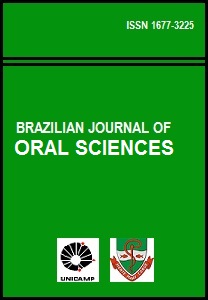Abstract
Streptococci species were isolated, identified and counted in 262 saliva samples collected from 131 children and adolescents from a public school nursery at the city of Jaboticabal, SP. Four Streptococci species harboring oral samples were identified biochemically, as Streptococcus salivarius, Streptococcus mutans, Streptococcus rattus, Streptococcus sobrinus, and streptococci of the mitis group. The mean Streptococcus counts obtained were 1.0 x 109 CFU/ml saliva for the 3 to 5 year age range, 1.5 x 109 CFU/mL saliva for the 6 to 8 year age range, and 2.0 x 109 CFU/mL saliva for the 12 to 14 year age range. The prevalence of Streptococci in saliva were: S. salivarius (89.31%), S. mutans (73.28%), S. salivarius + S. mutans (44.27%) by the standard method. The tongue depressor method showed S. mutans (62.59%), S. salivarius (77.86%), S.salivarius + S. mutans (33.58%). The analysis of both techniques showed significant agreement for Streptococcus isolation.References
Whiley, R. A, Beighton, D. Current classification of the oral streptococci. Oral Microbiol Immunol. 1998; 13: 195-216.
Thurnheer T, Gmur R, Giertsen E, Guggenheim B. Automated fluorescent in situ hybridyzation for the specific detection and quantification of oral streptococci in dental plaque. J Microbiol Methods. 2001; 44: 39-47.
Loesche, W. J. Role of Streptococcus mutans in human dental decay. Microbiol Rev. 1986; 50: 353-80.
Kleinberg, I. A mixed-bacteria ecological approach to understanding the role of the oral bactera in dental caries causation: na alternative to Streptococcus mutans and the specific-plaque hypothesis. Crit Rev Biol Med. 2002; 13(2): 108-25.
Kristofersson K, Grondahl JG, Bratthall D. The more Streptococcus mutans, the more caries on approximal surfaces. J Dent Res. 1985; 64: 58-61.
Höfling JF, Spolidório DMP, Pereira CV, Rosa EAR, Moreira D.
Presença de Streptococcus mutans associado a Streptococcus sobrinus em escolares de diferentes classes sócio-econômicas e sua relação com a atividade cariogênica dessas populações. Rev Odontol Univ São Paulo. 1999; 13: 173-80.
Balakrishnan M, Simmonds RS, Taggs JR. Dental caries is a preventable infectious disease. Aust Dent J. 2000; 45: 235-45.
Igarashi T. Yamamoto A., Goto N. Polymerase chain reaction for identification of oral streptococci: Streptococcus mutans, Streptococcus sobrinus, Streptococcus downei and Streptococcus salivarius. J. Microbiol Methods. 1998; 34: 81-91.
Rogers AH. The proportional distribution and characteristics of streptococci in human dental plaque. Caries Res. 1969; 3: 238-48.
Alaluusua S, Renkonen OV. Streptococcus mutans establishment and dental caries experience in children from 2 to 4 years old. Scan. J. Dent Res. 1983; 9: 453-7.
Carlsson J, Gandour I A, Olsson B, Rickardsson B, Abbas K. Hight prevalence of mutans streptococci in a population with extremely low prevalence of dental caries. Oral Microbiol Immunol. 1987; 2: 121-4.
Cantisano, M. H. Determinação do número de Streptococcus mutans na saliva de crianças com 6 years de idade e diferentes experiências de cárie. Bauru. [Master’s Thesis in Pediatric Dentistry]. Bauru: Faculdade de Odontologia de Bauru, Universidade de São Paulo; 1981.
Torres, S. A. Avaliação do ágar SB20 e MSB na contagem de estreptococos do grupo mutans na saliva e na placa dental de adolescentes. Araraquara. [Doctoral Thesis in Pediatric Dentistry].
Araraquara: Faculdade de Odontologia de Araraquara, Universidade Estadual Paulista Júlio de Mesquita Filho; 1990.
Grábris K, Nagy G, Madléna M, Dénes Z, Márton S, Készthelyi G, Bánóczy J. Associations between microbiological and salivary activity tests and caries experience in Hungarian adolescents. Caries Res. 1999; 33: 191-5.
Fujiwara T, Sasada E, Mima N, Ooshima T. Caries prevalence and salivary mutans streptococci in 0-2-year-old children of Japan. Community Dent Oral Epidemiol. 1991; 19: 151-4.
Roters FJM, Van De Hoeven JS, Burgersdijk RCW, Schaeden MJM.
Lactobacilli, mutans streptococci and dental caries: A longitudinal study in 2-year-old children up to the age of 5 years. Carie Res. 1995; 29: 272-9.
Matee MIN, Mikx FHM, Frencken JEFN, Truin GJ, Ruikein HMHM. Selection of a micromethod and its use in the estimation of salivary Streptococcus mutans and Lactobacillus counts in relation to dental caries in Tanzanian children. Carie Res. 1985; 19: 497-506.
Edwardsson S, Kock G, Öbrink M. Streptococcus sanguis, Streptococcus mutans and Streptococcus salivarius in saliva.
Prevalence and relation to caries increment and prophylatic measures. Odont Revy. 1972; 23: 279-96.
Grindefjord M, Dahllöf G, Módeer T. Caries development in children from 2.5 to 3.5 years of age: A longitudinal study. Carie Res. 1995; 29: 449-54.
Shklair I. L., Keene H. J. A biochemical scheme for the separation of type five varieties of Streptococcus mutans. Arch. Oral Biol.. 1974; 19 (11):1079-81.
Igarashi T., Ichikawa K., Goto N. Identification of mutans streptococcal species by the PCR products of the dex genes. J Microbiol Methods. 2001; 46: 99-105.
The Brazilian Journal of Oral Sciences uses the Creative Commons license (CC), thus preserving the integrity of the articles in an open access environment.

